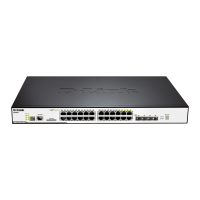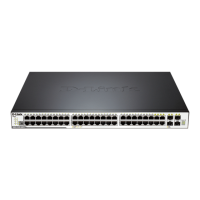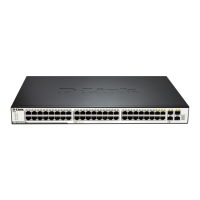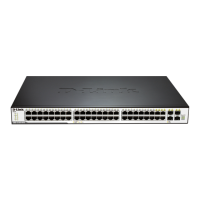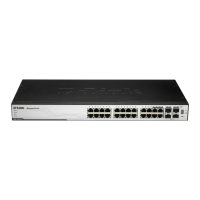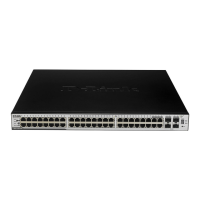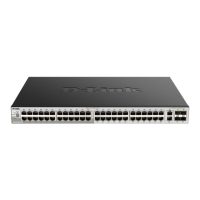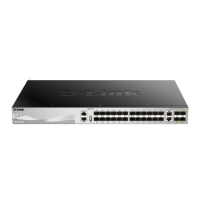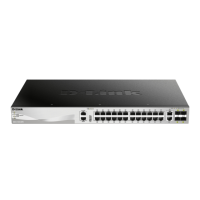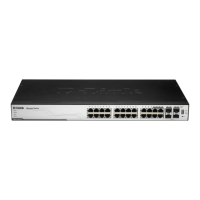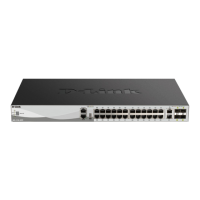Do you have a question about the D-Link DGS-3120-24TC and is the answer not in the manual?
Overview of managing, configuring, and monitoring the switch via its embedded web-based interface.
Procedure to access the switch's management interface via a web browser using its IP address.
Overview of the user interface, its windows, and access to configuration and management.
Description of the three distinct areas dividing the web-based user interface: menu, status, and information areas.
Displays essential switch information like MAC address, firmware version, and hardware version.
Allows entry of System Name, Location, and Contact to define and identify the switch.
Configuration options for switch ports, including speed, duplex, flow control, and MDIX settings.
Configuration for Power over Ethernet features, including system and port settings.
Settings for configuring how and where system log information is saved.
Manages user accounts, privileges, and access rights for switch management.
Information and configuration for switch stacking, including topology and mode settings.
Configuration and management of Address Resolution Protocol entries for IP to MAC address translation.
Configuration of IP addresses, subnet masks, and gateways for managing the switch.
Global settings for managing the switch, including CLI paging, power saving, and DHCP auto-configuration.
Concept and configuration for managing multiple switches using a single IP address.
Configuration for Simple Network Management Protocol (SNMP) versions, traps, and global settings.
Configuration for enabling/disabling Telnet and Web-based management access.
Configuration and management of Virtual Local Area Networks (VLANs) for network segmentation.
Configuration and management of Spanning Tree Protocols (STP, RSTP, MSTP) to prevent network loops.
Combines multiple ports into a single logical link for increased bandwidth and redundancy.
Configuration of the Forwarding Database (FDB) for static unicast and multicast forwarding.
Manages multicast traffic control features like IGMP and MLD snooping.
Configuration of Link Layer Discovery Protocol (LLDP) for network device discovery.
Configures default IPv4 routes using IP address, subnet mask, and gateway.
Configures static IPv4 routes and floating static routes for network traffic forwarding.
Configures static IPv6 routes for network traffic forwarding.
Displays the switch's direct connected IP information for routing.
Configures 802.1p priority queuing for Quality of Service (QoS) on the switch.
Sets bandwidth limits on transmitting and receiving data rates for selected ports.
Enables or disables storm control and adjusts thresholds for multicast and broadcast storms.
Configures Differentiated Services Code Point (DSCP) trust and mapping settings for QoS.
Prevents Head-of-Line (HOL) blocking by forwarding packets to lower latency paths.
Configures QoS scheduling mechanisms for mapping packets to hardware priority queues.
Assists in creating access profiles and ACL rules by specifying addresses, services, and actions.
Manages access profiles and rules to control packet forwarding based on header information.
Configures egress access profiles for per-flow packet processing as packets leave the switch.
Implements IEEE 802.1X standard for port-based network access control using RADIUS authentication.
Configuration and management of RADIUS server settings for centralized authentication.
Restricts switch port access by binding IP and MAC addresses, preventing unauthorized users.
Manages MAC-based access control for authenticating users via MAC addresses.
Authenticates users accessing the internet via the switch using HTTP or HTTPS protocols.
Secures ports by locking the MAC address forwarding table to prevent unauthorized MAC addresses.
Configures settings to prevent ARP spoofing attacks by validating ARP packets against gateway information.
Protects against BPDU attack by configuring port states and actions when attack is detected.
Detects and prevents network loops by temporarily shutting down ports experiencing loop-back events.
Manages authentication methods and server groups for user access control.
Configures Secure Sockets Layer (SSL) for secure communication, including cipher suites.
Configures Secure Shell (SSH) for secure remote login and network services.
Configuration for Connectivity Fault Management (CFM) parameters, including settings for MD, MA, and MEP.
Configuration and monitoring for Ethernet Operations, Administration, and Maintenance (OAM) functions.
Tests and verifies copper cable quality and identifies cable errors.
Monitors CPU, DRAM, and Flash utilization of the switch.
Monitors packet statistics for individual ports, including received, transmitted, and error counts.
Configures port mirroring and sFlow for traffic monitoring and analysis.
Performs network connectivity tests like Ping and Trace Route.
Saves the switch's current configuration or log file to a computer or permanently saves changes.
Downloads firmware to the switch or uploads firmware from the switch to a server.
Downloads or uploads the switch's configuration file from/to TFTP or HTTP servers.
Resets the switch to factory defaults or reboots the system with options to save configuration.
Overview of managing, configuring, and monitoring the switch via its embedded web-based interface.
Procedure to access the switch's management interface via a web browser using its IP address.
Overview of the user interface, its windows, and access to configuration and management.
Description of the three distinct areas dividing the web-based user interface: menu, status, and information areas.
Displays essential switch information like MAC address, firmware version, and hardware version.
Allows entry of System Name, Location, and Contact to define and identify the switch.
Configuration options for switch ports, including speed, duplex, flow control, and MDIX settings.
Configuration for Power over Ethernet features, including system and port settings.
Settings for configuring how and where system log information is saved.
Manages user accounts, privileges, and access rights for switch management.
Information and configuration for switch stacking, including topology and mode settings.
Configuration and management of Address Resolution Protocol entries for IP to MAC address translation.
Configuration of IP addresses, subnet masks, and gateways for managing the switch.
Global settings for managing the switch, including CLI paging, power saving, and DHCP auto-configuration.
Concept and configuration for managing multiple switches using a single IP address.
Configuration for Simple Network Management Protocol (SNMP) versions, traps, and global settings.
Configuration for enabling/disabling Telnet and Web-based management access.
Configuration and management of Virtual Local Area Networks (VLANs) for network segmentation.
Configuration and management of Spanning Tree Protocols (STP, RSTP, MSTP) to prevent network loops.
Combines multiple ports into a single logical link for increased bandwidth and redundancy.
Configuration of the Forwarding Database (FDB) for static unicast and multicast forwarding.
Manages multicast traffic control features like IGMP and MLD snooping.
Configuration of Link Layer Discovery Protocol (LLDP) for network device discovery.
Configures default IPv4 routes using IP address, subnet mask, and gateway.
Configures static IPv4 routes and floating static routes for network traffic forwarding.
Configures static IPv6 routes for network traffic forwarding.
Displays the switch's direct connected IP information for routing.
Configures 802.1p priority queuing for Quality of Service (QoS) on the switch.
Sets bandwidth limits on transmitting and receiving data rates for selected ports.
Enables or disables storm control and adjusts thresholds for multicast and broadcast storms.
Configures Differentiated Services Code Point (DSCP) trust and mapping settings for QoS.
Prevents Head-of-Line (HOL) blocking by forwarding packets to lower latency paths.
Configures QoS scheduling mechanisms for mapping packets to hardware priority queues.
Assists in creating access profiles and ACL rules by specifying addresses, services, and actions.
Manages access profiles and rules to control packet forwarding based on header information.
Configures egress access profiles for per-flow packet processing as packets leave the switch.
Implements IEEE 802.1X standard for port-based network access control using RADIUS authentication.
Configuration and management of RADIUS server settings for centralized authentication.
Restricts switch port access by binding IP and MAC addresses, preventing unauthorized users.
Manages MAC-based access control for authenticating users via MAC addresses.
Authenticates users accessing the internet via the switch using HTTP or HTTPS protocols.
Secures ports by locking the MAC address forwarding table to prevent unauthorized MAC addresses.
Configures settings to prevent ARP spoofing attacks by validating ARP packets against gateway information.
Protects against BPDU attack by configuring port states and actions when attack is detected.
Detects and prevents network loops by temporarily shutting down ports experiencing loop-back events.
Manages authentication methods and server groups for user access control.
Configures Secure Sockets Layer (SSL) for secure communication, including cipher suites.
Configures Secure Shell (SSH) for secure remote login and network services.
Configuration for Connectivity Fault Management (CFM) parameters, including settings for MD, MA, and MEP.
Configuration and monitoring for Ethernet Operations, Administration, and Maintenance (OAM) functions.
Tests and verifies copper cable quality and identifies cable errors.
Monitors CPU, DRAM, and Flash utilization of the switch.
Monitors packet statistics for individual ports, including received, transmitted, and error counts.
Configures port mirroring and sFlow for traffic monitoring and analysis.
Performs network connectivity tests like Ping and Trace Route.
Saves the switch's current configuration or log file to a computer or permanently saves changes.
Downloads firmware to the switch or uploads firmware from the switch to a server.
Downloads or uploads the switch's configuration file from/to TFTP or HTTP servers.
Resets the switch to factory defaults or reboots the system with options to save configuration.
| Primary Function | Managed Switch |
|---|---|
| Ports | 24 x 10/100/1000Base-T |
| Switching Capacity | 48 Gbps |
| Forwarding Rate | 35.7 Mpps |
| MAC Address Table Size | 16K entries |
| RAM | 128 MB |
| Flash Memory | 32 MB |
| VLAN Support | Yes |
| Uplink Ports | 4 x 1G SFP |
| Jumbo Frame Support | 9KB |
| Layer 3 Features | Static Routing |
| Power Supply | AC 100-240V, 50/60Hz |
| Power Consumption | 30 Watts |
| Operating Temperature | 0 to 50 °C |
| Storage Temperature | -40°C to 70°C |
| Humidity | 10% to 90% non-condensing |
